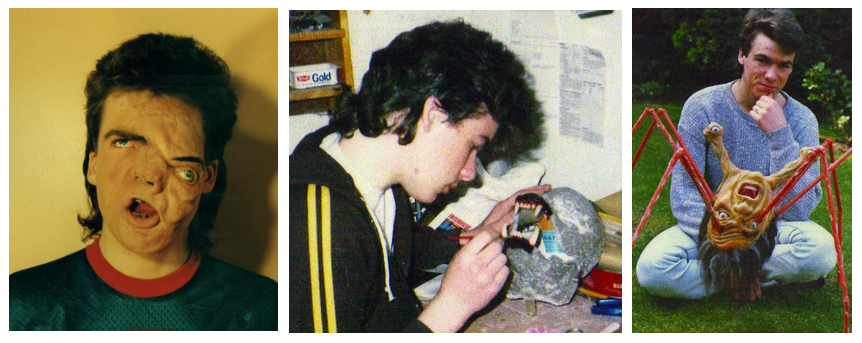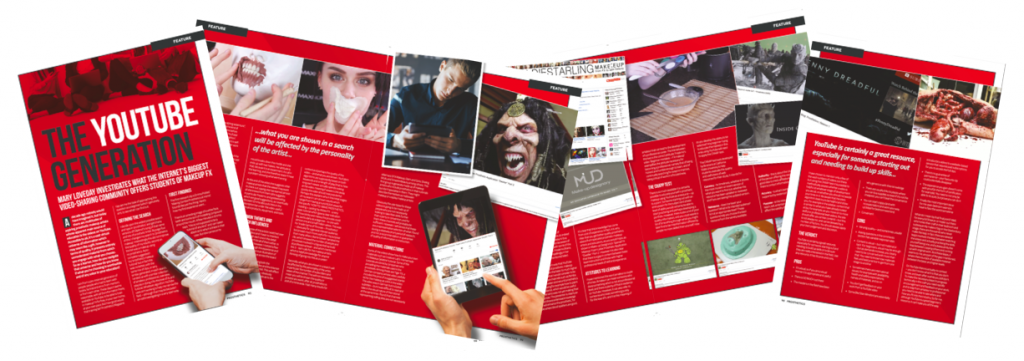If you’re completely new to the world of prosthetics and makeup FX it can be hard to know where to start exploring it in a constructive way. If you enjoy seeing prosthetics in movies, TV and at leisure attractions such as Halloween haunts you may well be interested in learning some of the skills yourself, but where do you start?
Like many industry prosthetics artists of his generation Neill Gorton is self-taught, spending a lot of time in his parents’ garden shed in his youth learning by trial and error as the pics in this article show! Over 30 years later he’s a multi-award winning prosthetics designer, founder of one of Europe’s largest and longest-standing industry companies and an influential educator himself, so he has a lot of experience and wisdom to offer beginners…

What is your learning goal?
Neill’s advice is that if you’re interested in learning the subject you first need to ask yourself this question: do I want to start learning it as the first step towards a career, or just learn it for fun? Either way is good as whilst it can be an exciting and fruitful career, it can also be a really rewarding hobby and open up a whole new world of creativity and like-minded friends for you as such.
This question matters however, because what you do next and how you approach your learning will be different depending on which path you go down. Here Neill looks at each and why…
As a hobby: people who do makeup FX and prosthetics as a hobby will use their skills to create cosplay costumes or for Halloween events and parties. It’s all for your own pleasure and you create the things you want to create in the way you want to create them. This means the subject matter tends to involve more visually impactful creations such as blood and gore FX or re-creations of famous characters. There’s a lot more out-of-the-kit type makeup involved and most people will work off their kitchen table using easily available materials.
As a career: the key difference in doing makeup FX and prosthetics as a career is you work to someone else’s brief and to meet the needs of your employer or a client. Rarely will you be required to reproduce an already famous character, and blood and gore FX make up only a very small portion of the work you would be expected to do. It tends to involve far less time actually doing makeup and far more time in workshops making moulds and executing processes that are more akin to fine art.
Starting out
So how does this affect you when you’re starting out and seeking ways to learn? The most obvious first steps are to learn from free online resources such as YouTube. Some tutorials are very good and some are very, VERY bad. If you’re looking to learn however, this is still a great way to start and the way these tutorials usually show someone applying makeup to themselves is the way you’re most likely to start learning. I know my first makeups were done on myself while looking in a mirror – like the creation below on the left from back in the mists of time!!

Is YouTube a good place to learn?
Although hugely varied in quality, some YouTube tutorials can be handy. Keep in mind though that these ‘free’ tutorials do come with a price. Those YouTubers earn money by having you click on their links, so rather than focus on core skills that are useful to a professional, they’re instead going to focus on eye-catching and simple tutorials that mostly involve creating gore FX using out-of-the-kit makeup. There’s a great article in issue 10 of Prosthetics Magazine that explores what YouTube has to offer as an educational tool and helps you with tips on what to search for to get more reliable results.

While the results of these are fun and serve the purpose of being noticeable for online tutorials, the results are not film quality and the techniques are far too basic and fragile to be used for a professional film shoot. The reality is that professional prosthetics and makeup FX tend to take a lot more time to create than could ever be crammed into a 30-minute online tutorial. In fact, a professional prosthetic will usually take a number of weeks to prepare and involve a lot of technical processes that will make for far less exciting viewing on YouTube.
So if what you see on YouTube is the fun stuff you want to do as a hobby then certainly use that as your mode of learning. Should you wish to advance your hobby further or want to pursue this as a career however, then you’ll want to take a step up and look at subscribing to something like our own online school which has a large amount of step-by-step tutorials that I teach personally, or taking an in-real-life course.
Three things to try at home
Whether you’re being guided by YouTube for fun or planning to take a course for career development there are a some skills you can practice at home at very little cost to help you on your way:
- Prosthetics is about learning to change the face in 3D, but first understand how the face can be shaped in 2D with theatrical highlighting and shadowing techniques and this will provide you with a very solid foundation on which to build. This requires nothing more complicated than a couple of art brushes and some black and white face paint to achieve
- Understanding anatomy is hugely important. Artists creating even the most fantastical creations have drawn inspiration from real anatomy to produce convincing creatures. You’ll find inexpensive anatomy books for artists in almost any bookshop and if you want to take this a step further you can look for a local life study class or night school to join
- Sculpture is a fundamental skill used all the time in prosthetics so the better you are at it, the better chance you stand of making good prosthetics. When you’re first starting out it takes some time to get used to the feel of the clay and what it’s like to work with. It can take time to really get familiar with it and this is something you can work on easily at home. Clays are quite inexpensive and easy to source, so you can experiment with this material at your own pace and on your own time. This can be done simply using regular pottery clay and books such as the following, which I have quoted the International Standard Book Number for, so you can find them online and in shops:
Modelling the Head in Clay – Margit Malmstrom. ISBN 10: 0823030997
Modelling in Clay – Dorothy Arthur, ISBN 10: 0713667494
Also have a look at books and YouTube videos by sculptor Philippe Faraut like the example below:
Neill’s essential advice for the ambitious
Neill is founder and co-director of multi-award winning film industry prosthetics company Millennium FX and has hired hundreds and hundreds of prosthetics and makeup FX artists over the past 30 years, so he knows a thing or two about pointing beginners with high aspirations in the right direction. So what’s the one piece of absolutely pivotal advice that he gives to everyone starting out about how to get hired as a prosthetics artist?
“We hire TALENT AND SKILLS.
That’s it. There are no caveats to this, there’s no ‘it’s not what you know it’s who you know’, there’s no lottery or competition you can win that can get you a job and I certainly don’t employ people because of the number of likes and retweets they get on Facebook and Twitter, or because they have lots of followers on Instagram. I also don’t hire because you have certificates or qualifications. I hire…
TALENT AND SKILLS.
How do you show you have talent and skills? With a portfolio. With pictures of your creations. Detailed, clean, crisp pictures of your work and not just finished pieces; photographs of a process – moulds and sculptures and designs. All of that presented cleanly and in a manner that a potential employer can see and evaluate.”
Other learning resources
There are many, many different resources out there. Here are some we’re involved in and that we recommend:
Neill Gorton’s Makeup FX 911 group on Facebook. An invaluable source of advice for technical queries with many professional prosthetics artists on hand to share tips. It’s a closed group to prevent spammers, so please ask to join and you will be accepted
Neill’s Materials’ ‘how to’ videos: great demonstrations on how to use useful products
MFX Warehouse DVDs: step-by-step tutorials from Neill with online streaming options
Prosthetics Magazine: magazine full of invaluable tutorials and industry features – print and online subscriptions available
The Prosthetics Event: annual educational event in Coventry, UK every November – featuring back-to-back classes on two stages, demonstrations, specialist retail, career advice, exhibits and prize draws
Books: there are many helpful books out there – here are some examples:
No Strings Attached – The Inside Story of Jim Henson’s Creature Shop
Matt Bacon, published by Virgin 1997
Making a Monster – The Creation of Screen Characters
Al Taylor and Sue Roy, published by Crown 1980
Making Faces Playing God – Identity and the Art of Transformational Makeup
Thomas Morawetz, published by the University of Texas Press 2001
Special Effects – An Oral History
Pascal Pinteau, published by Abrams 2003
Sculpting a Galaxy – Inside the Star Wars Model Shop
Lorne Peterson, published by Insight Editions 2006
Special Makeup Effects for Stage and Screen: Making and Applying Prosthetics
Todd Debreceni, published by Focal Press, 3rd edition 2018
The Monstrous Make-up Manual
Mike Spatolla, 2 books available 2019
Steps you can take to support your skills
If you do have your sights set on a career as a prosthetics or makeup FX artist there are things you can do to augment your learning and that will stand you in good stead for employment later down the line:
- Stay away from blood and gore. It’s fun but not an avenue for specialist industry employment so once you’ve developed those skills, move on and don’t feature them heavily in your portfolio
- Find avenues for practising your skills. Volunteer for local theatre groups and help out on student films. There may not be any money in it but you’ll be working to a brief and a deadline and you’ll also be applying makeup to people other than yourself, which is a skill in itself
- In a similar vein, a part time job in a hairdressing salon is a good place to develop some fundamental skills. Prosthetic makeup artists need to know how to work with people, make them feel comfortable and confident. Even if it’s just washing the hair of someone you’ve only just met, there are a lot of parallels to the way a prosthetic makeup artist might deal with an actor who is being life cast or is having prosthetics applied
- Learn some basic photography skills and buy a decent point and shoot camera with a good lens. Photographs taken on a phone tend to be poor quality and get compressed in weird ways, which makes them hard to produce as good quality prints to go in a portfolio. There’s no point putting lots of time, effort and money into creating a great portfolio piece only to take a bad photograph of it! There’s a great article in issue 6 of Prosthetics Magazine that will help you get started with this.
To sign off this bumper crop of advice I wish you luck in your learning and I hope you enjoy the wonderful craft of prosthetics as much as I do!






